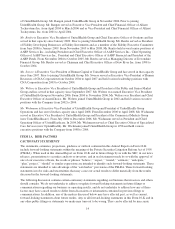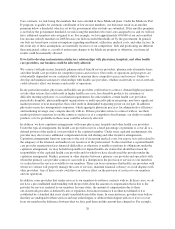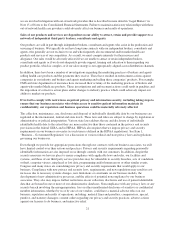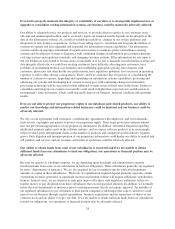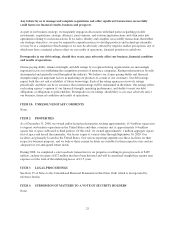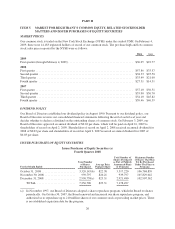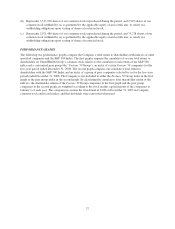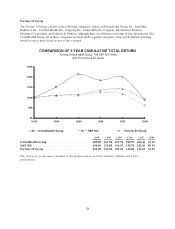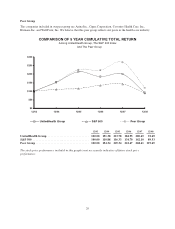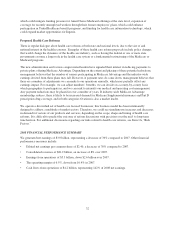United Healthcare 2008 Annual Report Download - page 33
Download and view the complete annual report
Please find page 33 of the 2008 United Healthcare annual report below. You can navigate through the pages in the report by either clicking on the pages listed below, or by using the keyword search tool below to find specific information within the annual report.completed their review of the Company’s historical stock option practices and reported the findings to the
non-management directors of the Company. As a result of our historical stock option practices, we restated our
previously filed financial statements, we incurred certain cash and non-cash charges, we are subject to various
regulatory inquiries and litigation matters, and we may be subject to further regulatory inquiries, litigation
matters, and cash and noncash charges, the outcome of any or all of which could have a material adverse effect
on us. See Note 15 of Notes to the Consolidated Financial Statements for a more detailed description of these
regulatory inquiries and litigation matters.
Our investment portfolio may suffer losses which could materially adversely affect our financial results.
Fluctuations in the fixed income or equity markets could impair our profitability and capital position. Volatility
in interest rates affects our interest income, and the market value of, our investments in fixed income debt
securities of varying maturities, which comprise the majority of the fair value of our investments at
December 31, 2008. In addition, defaults by issuers, primarily from investments in liquid corporate and
municipal bonds, who fail to pay or perform on their obligations, could reduce our investment income and net
realized investment gains or result in net realized investment losses as we may be required to write down the
value of our investments, which would adversely affect our profitability and shareholders’ equity.
We also invest a small proportion of our investments in equity investments, which are subject to greater volatility
than fixed income investments. General economic conditions, stock market conditions, and many other factors
beyond our control can adversely affect the value of our equity investments and may result in investment losses.
There can be no assurance that our investments will produce total positive returns or that we will not sell
investments at prices that are less than the carrying value of these investments. Changes in the value of our
investment assets, as a result of interest rate fluctuations, illiquidity or otherwise, could have a negative effect on
our shareholders’ equity. In addition, if it became necessary for us to liquidate our investment portfolio on an
accelerated basis, it could have an adverse effect on our results of operations.
If the value of our intangible assets is materially impaired, our results of operations, shareholders’ equity
and debt ratings could be materially adversely affected.
Due largely to our past acquisitions, goodwill and other intangible assets represent a substantial portion of our
assets. Goodwill and other intangible assets were approximately $22.4 billion as of December 31, 2008,
representing approximately 40% of our total assets. If we make additional acquisitions, it is likely that we will
record additional intangible assets on our books. We periodically evaluate our goodwill and other intangible
assets to determine whether all or a portion of their carrying values may no longer be recoverable, in which case
a charge to earnings may be necessary. Any future evaluations requiring an asset impairment of our goodwill and
other intangible assets could materially affect our results of operations and shareholders’ equity in the period in
which the impairment occurs. A material decrease in shareholders’ equity could, in turn, negatively impact our
debt ratings or potentially impact our compliance with existing debt covenants.
Large-scale medical emergencies may result in significant health care costs and may have a material
adverse effect on our business, financial condition and results of operations.
Large-scale medical emergencies can take many forms and can cause widespread illness and death. Such
emergencies could materially and adversely affect the U.S. economy in general and the health care industry
specifically. For example, in the event of a natural disaster, bioterrorism attack, pandemic or other extreme
events, we could face, among other things, significant health care costs and increased use of health care services.
Any such disaster or similar event could have a material adverse effect on our business, financial condition and
results of operations.
23



